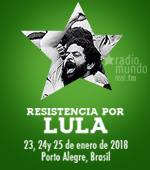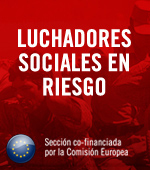
21 de octubre de 2009 | Noticias | Caducando la impunidad | Derechos humanos
No More Silence
A present past, a better future
4:00 minutes
Descargar: MP3 (2.7 MB)
Next Sunday, Uruguay will decide –in a plebiscite which will be held together with presidential elections- on the repeal of a law which has ensured impunity for those who violated human rights during the last military dictatorship, which took place in the country from 1973 to 1985.
1989 was the year when the worst case scenario became a reality, after a long campaign to obtain the necessary amount of signatures to put to vote the impunity law, which protects military officers who violated human rights during the last military dictatorship. In that year, the law was kept with 52% of votes, against 40% of the population who wanted to repeal it.
This was the shadow of the dictatorship by the end of the 80s. The fear of its return, hidden (and not so hidden) threats to the citizenship by those who kidnapped an entire country for twelve years with the support of great part of the political system of the time and the mainstream media, had prevailed. Now, there were two kinds of citizens, those who the Judicial Power couldn´t touch, and the rest of us.
Seven years had to pass for memory, for will for justice and a “Never Again” to State terrorism went to the streets again. On May 20th, 1996, the first “March of Silence” was carried out: the date was not chosen by chance. On May 20th, 1976, Senators Zelmar Michelini and Hector Gutierrez Ruiz, left-wing activists Rosario Barredo and William Whitelaw were murdered by the dictatorships of the Southern Cone and Manuel Liberoff was disappeared. Despite the efforts by the rulers to deny the past, it reemerged. Injustice can be declared in documents, but cannot be sustained.
Year after year, the demonstration grew in numbers, and the issue was back on the agenda. So much so that right wing President Jorge Batlle called by the beginning of this decade a commission to investigate what had happened to the disappeared people and kidnapped children. But it was not until left-wing party Frente Amplio came to office that some of the people who had violated human rights during the dictatorship were held accountable for their crimes.
With a new interpretation of the impunity law, the Executive power understood that high officers of the dictatorship were not protected by it, which resulted in some of them facing trial.
The first remains of disappeared people also appeared. Steel worker Ubagesner Chavez Sosa was the first to appear, who was buried in an air base. His proper burial was not only homage to his commitment and struggle, but also a clear “Enough”.
In 2008, the Workers Union (PIT-CNT), organizations of families of disappeared people, former political prisoners, the Federation of University Students (FEUU), several civil society organizations, some political groups, among other organizations, stated it was time to put an end to the situation. There was no more fear, impunity had to be ended once and for all. 250,000 signatures were necessary to put the matter to vote. 340, 000 were gathered.
A few days before the plebiscite in Uruguay, the Supreme Court of Justice ruled that the law was unconstitutional with reference to the case of Nibia Sabalsagaray, a communist teacher who was murdered in a torture centre after being caught painting a wall which read “Down with the dictatorship”.
On October 20th, 2009, a demonstration for the last 20th was called. Thousands of people crowded the main avenue of Montevideo. Most of them were young people, showing that the repeal of the law is not only an end to a sad chapter of the history of the South, but the beginning of a better future.
Photo: Radio Mundo Real
Artículos relacionados
- No más silencio
Un pasado presente, un futuro mejor - ¡A quebrar la Impunidad!
Producción radial de Radioactiva FM y Corsaria FM - Pasaje de ida
Justicia argentina extraditará a uruguayo que integraba el Escuadrón de la Muerte - Contra la mordaza
La derecha uruguaya está silenciando la campaña contra la impunidad
Página anterior | Página siguiente








